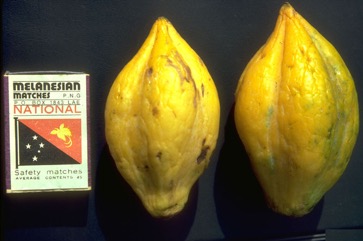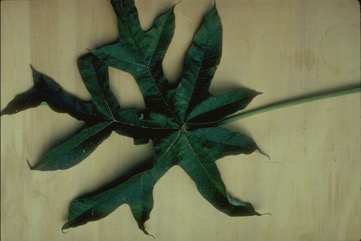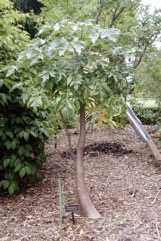Mountain papaya

They will grow to a higher altitude than common pawpaws. They grow at least between 1750 and 2200 m altitude. They can stand light frosts. They like a warm, dry site. They need shelter from the wind. It can grow in cooler tropical and subtropical climates. It suits a temperate between 10°C and 24°C. It benefits by plenty of rain. In the Andes it will grow above 2600 m altitude. It suits hardiness zones 10-11.
Also known as:
Bonete, Chamburo, Chamburu, Chiglacon, Chilhuacan, Hembra, Huanarpu, Kondapapaya, Papaya de monte, Papaya ve altura, Titi-ish, Toronchi
Synonyms
- Carica candamarcensis Hook.f.
- Carica cestriflora (A. DC.) Solms
- Carica chiriquensis Woodson
- Carica pubescens Lenne & K. Koch
- Carica cundinamarcensis Linden, nom. nud.
- Papaya cundinamarcensis Kuntze
- Papaya pubescens (A. DC.) Kuntze
- Vasconcellea cestriflora A. DC.
- Vasconcellea cundinamarcensis V. M. Badillo
Edible Portion
- Fruit
Where does Mountain papaya grow?
Found in: Africa, Andes, Argentina, Asia, Australia, Bolivia, Brazil, Central Africa, Central America, Chile, Colombia, Congo, East Africa, Ecuador, India, Indonesia, Mexico, Pacific, Panama, Papua New Guinea, PNG, Peru, Philippines, SE Asia, South America, Sri Lanka, Venezuela
Notes: There are at least 22-40 species of Carica.
Status: Only a few plants occur in Papua New Guinea and fruit is rarely used.
Growing Mountain papaya
Cultivation: They are grown from seed. Plants can be male, female or both sexes. Seeds germinate easily. They can grow in 30 days. Occasionally cuttings are used.
Edible Uses: The fruit are eaten. It often needs to have sugar added. It is also made into jam. The fruit is usually cooked and used as a vegetable. The are also used for marmalade or juice.
Production: Trees are fast growing. Trees from seed can start flowering after one year. Trees produce in 2-3 years. A tree can produce 50-60 fruit in a season. A spacing of 3 m is probably suitable. One plan can produce 50-60 fruit over a growth period of 4 months.
Nutrition Info
per 100g edible portion| Edible Part | Energy (kcal) | Protein (g) | Iron (mg) | Vitamin A (ug) | Vitamin c (mg) | Zinc (mg) | % Water |
|---|---|---|---|---|---|---|---|
| - | - | - | - | - | - |
Mountain papaya Photos



References
Ambasta S.P. (Ed.), 2000, The Useful Plants of India. CSIR India. p 105 (As Carica candamarcensis)
Badillo, V.M. 1993. Caricaceae. Segundo esquema. Revista de la Facultad de Agronomía de la Universidad Central de la Universidad Central de Venezuela. Alcance 43.
Bircher, A. G. & Bircher, W. H., 2000, Encyclopedia of Fruit Trees and Edible Flowering Plants in Egypt and the Subtropics. AUC Press. p 83 (As Carica pubescens)
Bircher, A. G. & Bircher, W. H., 2000, Encyclopedia of Fruit Trees and Edible Flowering Plants in Egypt and the Subtropics. AUC Press. p 83 (As Carica candimarcensis)
Bodkin, F., 1991, Encyclopedia Botanica. Cornstalk publishing, p 215
Bourke, R. M., Altitudinal limits of 230 economic crop species in Papua New Guinea. Terra australis 32.
Burkill, I.H., 1966, A Dictionary of the Economic Products of the Malay Peninsula. Ministry of Agriculture and Cooperatives, Kuala Lumpur, Malaysia. Vol 1 (A-H) p 464 (As Carica candamarcensis)
Campbell, R.J. 1996. South American fruits deserving further attention. Pp. 431-439 In Progress in new crops. (J. Janick,eds.). ASHS Press, Arlington, VA.
Castillo, R. O., 1995, Plant Genetic Resources in the Andes: Impact, Conservation, and Management. Crop Science 35:355-360 (As Carica)
Coronel, R.E., 1982, Fruit Collections in the Philippines. IBPGR Newsletter p 9
Darley, J.J., 1993, Know and Enjoy Tropical Fruit. P & S Publishers. p 90
Etherington, K., & Imwold, D., (Eds), 2001, Botanica's Trees & Shrubs. The illustrated A-Z of over 8500 trees and shrubs. Random House, Australia. p 181
Facciola, S., 1998, Cornucopia 2: a Source Book of Edible Plants. Kampong Publications, p 73 (As Carica pubescens)
Flowerdew, B., 2000, Complete Fruit Book. Kyle Cathie Ltd., London. p 153 (As Carica candamarcensis)
French, B.R., 1986, Food Plants of Papua New Guinea, A Compendium. Asia Pacific Science Foundation p 204 (As Carica candamarcensis)
Gouldstone, S., 1978, Australian and New Zealand Guide to food bearing plants. Books for Pleasure. p 38 (As Carica candamarcensis)
Gouldstone, S., 1983, Growing your own Food-bearing Plants in Australia. Macmillan p 115 (As Carica candamarcensis)
Grandtner, M. M., 2008, World Dictionary of Trees. Wood and Forest Science Department. Laval University, Quebec, Qc Canada. (Internet database http://www.wdt.qc.ca)
Grandtner, M. M. & Chevrette, J., 2013, Dictionary of Trees, Volume 2: South America: Nomenclature, Taxonomy and Ecology. Academic Press p 686
Hermandez Bermejo, J.E., and Leon, J. (Eds.), 1994, Neglected Crops. 1492 from a different perspective. FAO Plant Production and Protection Series No 26. FAO, Rome. p15, 188
Jardin, C., 1970, List of Foods Used In Africa, FAO Nutrition Information Document Series No 2.p 124 (As Carica candamarcensis)
John, L., & Stevenson, V., 1979, The Complete Book of Fruit. Angus & Robertson p 289 (As Carica candamarcensis)
Kermath, B. M., et al, 2014, Food Plants in the Americas: A survey of the domesticated, cultivated and wild plants used for Human food in North, Central and South America and the Caribbean. On line draft. p 901 (As Vansoncellea cundinamarcensis)
Kiple, K.F. & Ornelas, K.C., (eds), 2000, The Cambridge World History of Food. CUP p 1749, 1817
Lyle, S., 2006, Discovering fruit and nuts. Land Links. p 103
Macmillan, H.F. (Revised Barlow, H.S., et al) 1991, Tropical Planting and Gardening. Sixth edition. Malayan Nature Society. Kuala Lumpur. p
Martin, F.W., C.W. Campbell and R.M. Ruberté. 1987.Perennial edible fruits of the tropics - An inventory. United States Department of Agriculture, Agricultural Research Service, Agriculture Handbook No. 642. Washington, D.C., USA. p 23
Morton, J. F., 1987, Fruits of Warm Climates. Wipf & Stock Publishers p 346 (As Carica candamarcensis)
PROSEA (Plant Resources of South East Asia) handbook, Volume 2, 1991, Edible fruits and nuts. (As Carica pubescens)
Scheldeman,X. 2002.Cultivation Potential of native fruit species in Loja province Ecuador:Case study on Cherimoya (Annona cherimola) and complex of Highland papayas (Vasconcellea spp.).Faculteit Landbouwkundige en Toegepaste Biologishe Wetenscappen.GENT.
Segura, S., et al, 2018, The edible fruit species in Mexico. Genet Resour Crop Evol (2018) 65:1767–1793
Storey, W. B., 1979, Pineapple, in Simmonds N.W.,(ed), Crop Plant Evolution. Longmans. London. p 21
Self, M., 199, Phoenix Seeds catalogue. p 16
USDA, ARS, National Genetic Resources Program. Germplasm Resources Information Network - (GRIN). [Online Database] National Germplasm Resources Laboratory, Beltsville, Maryland. Available: www.ars-grin.gov/cgi-bin/npgs/html/econ.pl (10 April 2000)
Van den Eynden, V., et al, 2003, Wild Foods from South Ecuador. Economic Botany 57(4): 576-603
Van den Eynden, V., E. Cueva and O. Cabrera. 1999. Plantas silvestres comestibles del sur del Ecuador – Wild edible plants of southern Ecuador. Ediciones Abya-Yala, Quito, Ecuador.
van Wyk, B., 2005, Food Plants of the World. An illustrated guide. Timber press. p 118
Vickery, M.L. and Vickery, B., 1979, Plant Products of Tropical Africa, Macmillan. p 38 (As Carica candamarcensis)
World Checklist of Useful Plant Species 2020. Royal Botanic Gardens, Kew